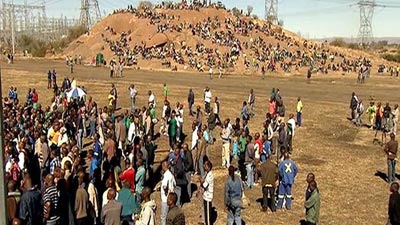The horrific events in Marikana on 16 August, 2012, that led to the killing of 34 striking mineworkers, are now reflected in visual artworks by the widows of the deceased men.
The artworks that consist of eight body map drawings, and nine hand drawings, are currently on display at the Institute for Reconciliation and Social Justice, on the Free State University’s Bloemfontein campus.
The paintings were done after the Khulumani Support Group introduced the widows to the transformative power of healing through art and storytelling.
The exhibition is the last instalment of the University’s Lecture Series this year on Trauma, Memory and Representations of the Past.
The theme of the discussion, “Speaking Wounds: voices of Marikana widows through art and narrative”, included panel members from the Khulumani Support Group.
National Director of Khulumani, Dr Marjorie Jobson says, “Artwork is a crucial part of a person identifying themselves as a victim of this massacre, and then sharing the story of what happened to their particular husband. Many women have a picture of their husband lying the ground dead. And then telling the story how it affected them in a group established a community of people affected by a particular incident. Out of that group they were able to make very strong demands on their lawyers in particular.”
“There is no justice yet apart from the fact that they stood up and demanded that as many of them as possible get jobs on the mine. So, at the moment 10 women are working for Lonmin. Some of them underground, realizing how incredible tough their husbands lives where. Some are cleaners others are first aid workers but that is not their desire. Some say we cannot leave our homes with the front door closed, the children are being put in boarding schools by Lonmin. We no longer have a home, we are here trying to put food on the table. What they asked Lonmin is to invest in enterprise opportunities where their homes are so that they can reconstitute a family without a breadwinner but with other possibilities to make a living,” adds Jobson.
National Organiser of Khulumani, Nomarussia Bonase says, “This art is a remarkable art which will send a message. It started here in SA with the university in Johannesburg and now in Free State and it went as far as going to Germany. This exhibition has been done in Germany, translated from English to Germany. The book of the stories of the Marikana women is still moving because next year we will be in Australia with the same story telling of the pain of the Marikana widows.”
Graphic Artist and Sociologist, Judy Seidman says, “I think art gives people time to find ways to express themselves. The words we use, are very restricted by society. Where you can find another way with colours. It’s also a way for yourself to value yourself, to create something beautiful.””
Each piece of artwork tells a different story of silence coming to life, of how those killings affected their lives, as well as their on-going journeys without that one special shoulder to lean on.
– By


